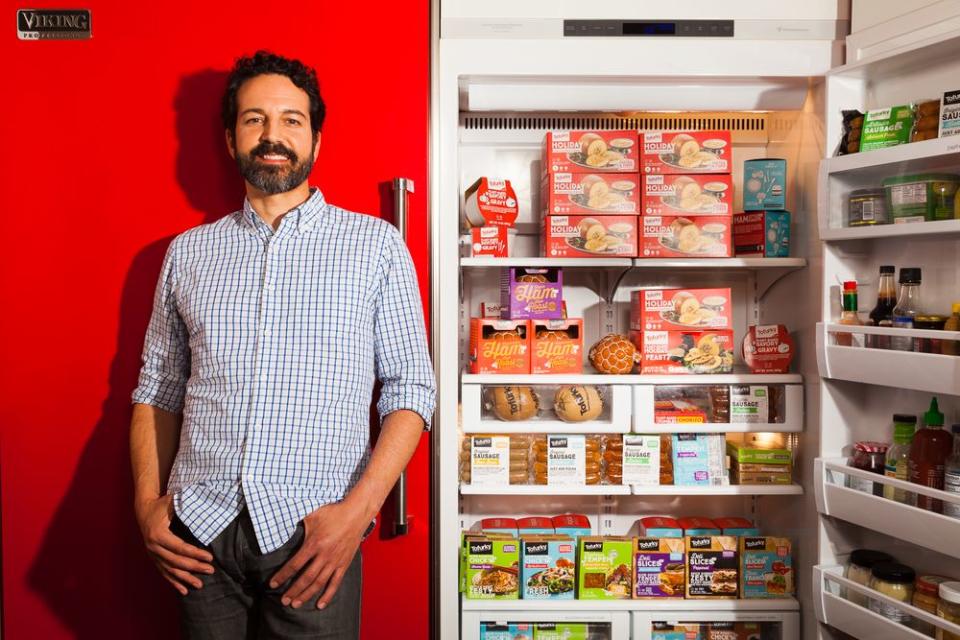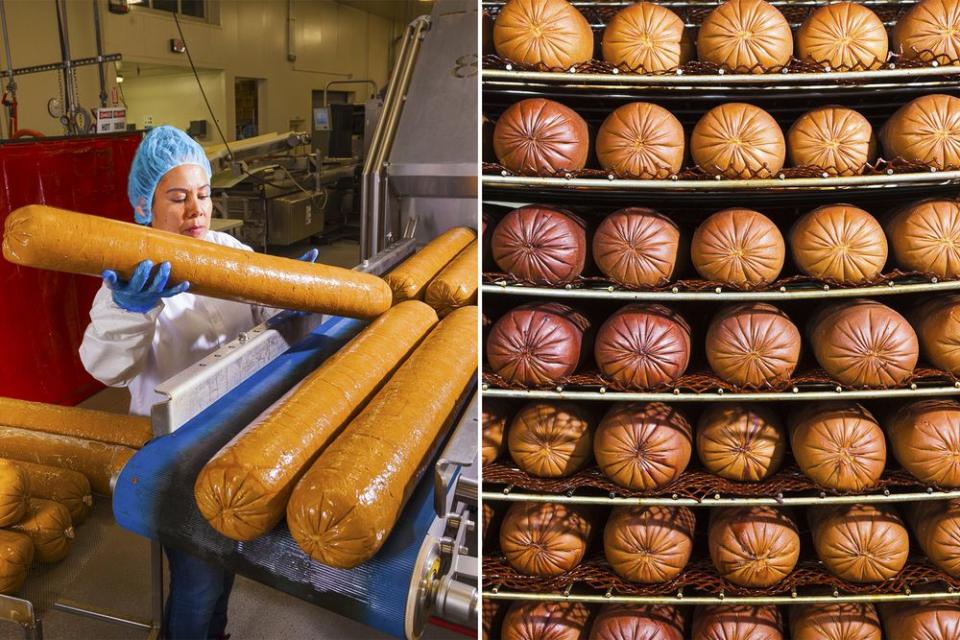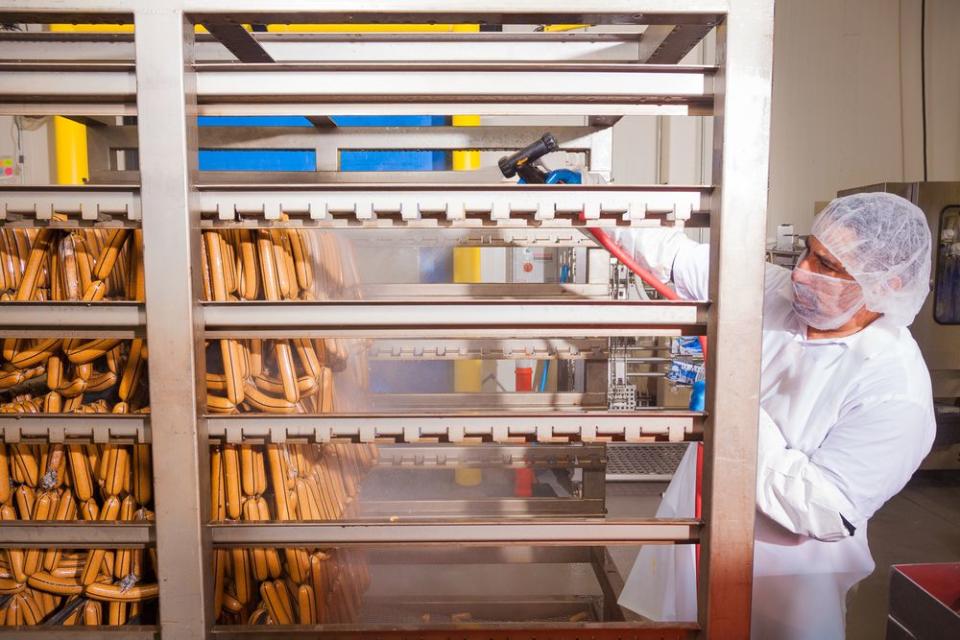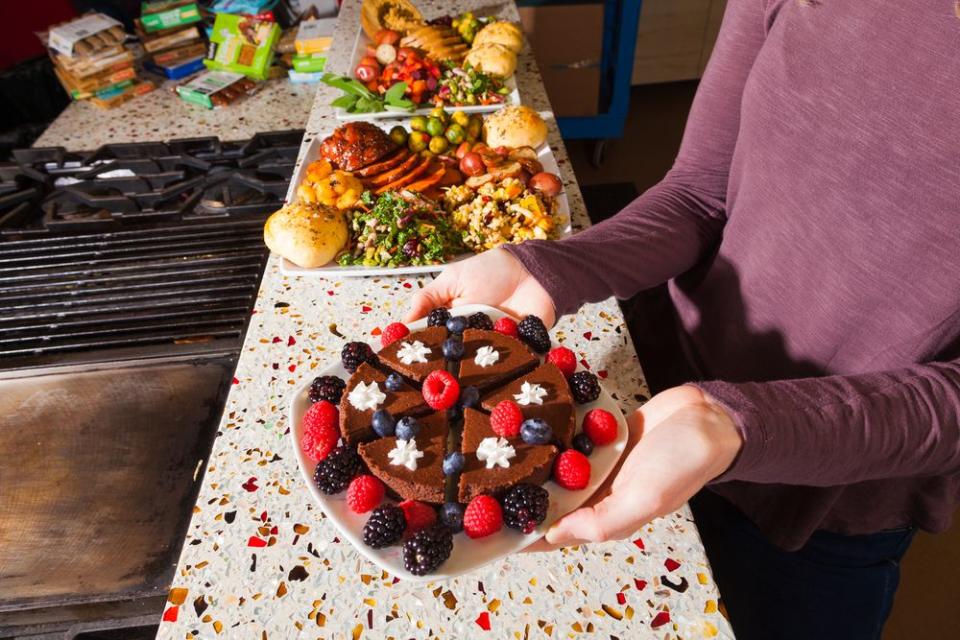Tofurky Wants to Save the World, One Thanksgiving Roast at a Time. It's Now Sold 5 Million
Ah, Thanksgiving: the annual holiday when Americans gather around the table with the people they’re closest to (genetically, at least) for a feast of traditional food, prayers, stories of gratefulness, and—hopefully silent—judgements about their friends and family. ‘I bet she voted for you-know-who,’ one likely muses. ‘He said what about my football team?’ wonders another. And, the more and more common refrain, ‘They’re serving a Tofurky this year!?’
But Tofurky is a lot more than simply the maker of the football-sized tofu loaf that’s helped give vegetarians and vegans a seat at the Thanksgiving table. A punchline practically since its founding, the Hood River, Ore. company has ridden out nearly four decades of good-natured ridicule to become one of the world’s leading meat-alternative makers, and perhaps the most recognized name in a space that’s been rushed by venture-backed startups like Impossible Foods and Beyond Meat.
And as the calendar turns towards another gravy-fueled holiday, the company has announced that it will sell its 5 millionth Thanksgiving roast this year—a number that proves Tofurky is no joke. (Though its not exactly a threat to the traditional bird: Americans buy 46 million turkeys each Thanksgiving.) Still, the milestone is about more than just sales, the company says.
“That’s five million times somebody took a personal risk to show up to a Thanksgiving meal with something that was weird,” says Erin Ransom, Tofurky’s head of marketing. “It’s five million times that somebody put the roast on the table and said ‘Try it with me—and if you like it that’s cool. Maybe there’s more for you in this way of eating.'”
Research suggests that all those risky dishes are starting to pay off. According to NPD’s annual Eating Patterns in America report, 14% of Americans are using plant-based proteins as a substitute for meat on a regular basis. In fact, nearly one in ten are eschewing meats that come from animals, with 1% of people identifying as vegan or vegetarian, and 8% partaking in flexitarian diets, which means they’re primarily vegetarian but occasionally partake in meat or fish. And they’re not just forgoing flesh over ethical or humane concerns; health and environmental worries are also causing people to rethink how they eat.
“That’s not a fad,” says Chase Worthen, a buyer of vegetarian products for Walmart, which stocks Tofurky products in 4,000 of its stores. “It’s a trend that’s here to stay.”
Tofurky’s Founding Father
Appropriately, given that Thanksgiving itself dates back to the Puritans, Tofurky has it’s own ties to a religious pilgrims—of a sort.
The company was originally founded as Turtle Island Foods in 1980 by Seth Tibbott, a free-spirited naturalist who at the time was taking his first tentative steps as a vegan. After reading Frances Moore Lappé’s Diet for a Small Planet in the late ’70s, Tibbot became concerned about his own food’s impact on the environment, so he began experimenting with ways to get more plant-based proteins onto his personal menu. But back then, even granola was thought of as hippy fare and not widely available. So when Tibbot came across an Indonesian soy food named tempeh, he decided to start making it himself.

Tibbot sent away for a small starter kit that taught him how to cook soy beans to make tempeh. Using an old lunch box as an incubator, he laid out his concoction in the sun to cook what eventually resulted in a soybean cake. Tibbot liked it, and when he started making it for his friends, they liked it too. Before long, there was enough demand for Tibbot’s vegan cooking that he realized he could turn it into a business.
Among Turtle Island’s earliest customers were the Rajneeshees, the spiritualist cult (recently popularized by the Netflix documentary Wild Wild Country) that established a city for itself in Oregon, about 100 miles from Hood River. In addition to serving as Turtle Island’s CEO, Tibbot also worked as the company’s delivery driver, typically bringing palates of tempeh by van to the camp to augment the new age pilgrims’ vegetarian diet. One time, Tibbot and some friends, en route to a Capture the Flag tournament in central Oregon, even delivered the tempeh by plane, touching down on the Rajneesh airstrip in a Cessna 142.
“My first paycheck from the company came back in the tempeh days, when we were a crew of around five people,” says 44-year-old Jaime Athos, Tibbot’s stepson, who is now Tofurky’s CEO. At the time, the company operated in half of a 5,000 square feet of industrial space. Tibbot subletted out the other 2,500 square feet as a yoga studio.
Tibbot puttered along with the company for 15 years before the actual Tofurky was invented in 1995. That’s when he noticed a problem with the holidays—and an opportunity in the market. “Maybe you’ve got a kind of prodigal son who goes off to college and he’s now a vegetarian, sort of like Seth was,” says Athos. “How do you include those folks in your traditional holiday meal that might have a turkey or a ham or both?”
Tibbot’s solution was a kit that included a kind of turkey-like roast for vegans, with side dishes to go with it. Made of a mix of tofu, wheat gluten, and other ingredients to mimic meat’s grainy, fleshy feel, Tofurkys have a brown rice and breadcube stuffing filled with herbs and vegetables, just like you’d find in the traditional holiday bird.
Tibbot’s first manufacturing run was around 500 cases, and he priced it around $30 per kit. Few grocers bit, and those that did were small co-ops like Seattle’s PCC Markets. Back then, it was “this little round roast with eight drumsticks,” as Tibbot told Business Insider. It was strange but it sold, and 15 years later the company, renamed Tofurky, had 69 employees and $14 million in annual revenue. Today Tofurky has 190 employees, 100,000 square feet across four buildings in Hood River, and sales in six of seven continents worldwide. Still a private, family-owned company, Athos declined to provide current financials.

As much as the magic was Tofurky’s mix of ingredients, it was the name that really sold the product, says Athos. “Tofurky is the name that Seth chose, and thankfully he did because it’s the sort of name that lends itself to being the punchline of jokes—and we’re happy to have people talking about us,” he says. And from The X-Files, to Conan O’Brien, to Tyler Perry and beyond, everyone has had had a laugh at Tofurky’s expense, giving the company a fixed place in American culture.
“The earned media that we got out of that, I think, was really instrumental,” says Athos. “The reason why it works as punch line is that it doesn’t take itself very seriously,” he says. “It’s quirky, it’s self deprecating, inherently, and I think that also addressed a problem that in the natural food space at the time, which was that this was a very serious business.”
How the (Meatless) Sausage Is Made
Puns and punchlines aside, Tofurky has become a very serious business with appeal stretching well beyond Thanksgiving. After the holiday roast caught on, the company started experimenting with other form factors like a shredded chicken replacement and a ground beef alternative. Eventually Tofurky’s other products became so successful that they were what kept the lights on.
For instance, by eliminating the stuffing from the holiday roast and thinly slicing the loafs, Tofurky developed lunch meat substitutes that feed people (and the business) year round. Tofurky’s deli slices are the company’s largest selling item by volume—and it’s still not enough, says Walmart. “Really, the customer demand has outstripped the supply,” says Worthen.

Similarly, Tofurky developed meatless sausages by cooking its mix in a film casing, much they way traditional frankfurters are made. Tofurky’s sausages are the company’s largest producer in terms of dollars and have the highest shelf velocity, the company says, meaning stores sell out of them the fastest. “We put it in every store we can,” Worthen says.
But watching the Tofurky plant hum along on an average day, it’s unclear how the company could output more product, unless it expanded its footprint. Located on the banks of the Columbia River in a light industrial area surrounded by microbreweries, coffee roasters, distilleries, and other stereotypically-Oregonian companies, Tofurky’s LEED-Platinum headquarters houses both the business and much of its production operations, with as light an ecological footprint as possible. Built with 90% of materials sourced from within 90 miles, the building has 400 photo-voltaic cells on the roof to minimize its energy-intensive cooking process. Solar tubes pull natural light down into the factory floor. The office’s walls are finished in a clay that can be remolded in case of nicks or gauges, and the carpeting is made of post-consumer recycled plastic.
When you step from the offices to the production floor, a warm, spicy aroma overwhelms the air, almost like walking into a home where someone is baking bread. “It reminds me of a kitchen,” says Marcia Walker, the company’s vice president of quality, research, and development. “It’s not distinguishable like turkey or something like that…. It’s more kind of a savory scent.”
The bread comparison extends beyond the scent. The first stage in the production process is creating a dough-like material the company calls ‘masa’ by mixing and kneading together ingredients like canola oil, soy sauce, wheat gluten, and tofu. Then the masa gets extruded into different shaped films and casings and flavored with herbs, spices, and vegetables—it’s even smoked in some cases—often with the same type of equipment used by animal-based sausage manufacturers, says Athos.

But unlike the horror scenes portrayed in meat-making documentaries, the Tofurky factory floor is clean and sterile, its ingredients are bagged and stacked on palates. And other than some water on the floor, the space is generally tidy as can be. “It’s the sort of thing that you can watch while you’re eating and not swear on a blood oath to never eat the food again,” Athos says. In other words, you wouldn’t mind knowing how the meatless sausage is made.
After the masa is mixed and extruded, it runs through an industrial oven that heats and cools the products cyclically, not just to cook the masa, but also to activate the ingredients in proprietary ways—essentially creating the magic that makes Tofurky taste and feel the way it does. And after smoking, slicing, pasteurizing, wrapping, and packaging, the goods are ready to be shipped off to stores, with some having shelf lives of up to 180 days. Take that, turkey.
Tofurky’s Tipping Point
Watching Tofurky being made can really turn a meat-eater on his or her head. After all, the company’s unconventional approach to protein is designed to simulate the look, taste, scent, and mouth-feel of animal flesh, though its ingredients are more akin to a veggie sandwich.
“A lot of people, strangely enough, they’ll not blink at eating an animal,” Athos says. “But they’ll look at something that has ingredients like tofu and gluten and say ‘Ew, gross.'”

Yet the numbers show an increasing amount of people are turning away from eating meat, for an array of reasons. The most obvious one is the ethical and animal welfare concerns. Beginning with 2008’s Food, Inc., documentaries about the meat industry’s practices started fueling more intense interest in plant-based proteins.
And last year, says Walmart’s Worthen, growth in the category skyrocketed. “Specifically vegan meat just exploded and became something that people who aren’t vegan would try,” he says. Walmart’s own purchasing demonstrates that mainstreaming perfectly. In May 2017, the retail giant began stocking Tofurky in 900 stores. A year and a half later, every location in the chain sells at least one of the company’s products.
Worthen says people are shifting their eating habits for holidays other than Thanksgiving, specifically this past year’s Fourth of July, when higher-than-usual veggie burger sales are already the norm. “I wasn’t expecting a huge lift in my vegan sausages and vegan hotdogs, but we saw a bigger lift than I’ve ever seen,” he says. “People are testing out meat alternatives on traditional holidays where meat is ingrained in the culture.”
Perhaps better than anyone, Athos, a life-long vegetarian, knows how personal this leveling up of plant-based meat can be. After all, people identify themselves—and others—based on what they eat, and this change has been a mental shift for many.

“What’s more masculine than big steaks, you know? And we definitely see ‘soy boy’ used as a derogatory term,” Athos says. “Elements of personal identity do come into meat choices, and a big plant-based burger just doesn’t have that cachet, that inherently macho, masculine feel to it. That’s challenging for a lot of people—it cuts to their own identity. It’s like, if I’m not a big masculine meat eating dude, what am I?”
For an increasing number of people, the answer to that question might simply be ‘alive.’ Health is another reason more people are turning away from animal proteins. In recent years, scientific research paired with a groundswell of food journalism has repeatedly shown that you can’t swing a rib-eye without hitting a report about what eating animals does to human bodies. For instance, diets high in red meat have long been risk factors for high cholesterol and cardiovascular disorders, says the National Institutes of Health. And according to the World Health Organization, daily consumption of processed meat can increase cancer risks by 18%. As if those weren’t enough, a study by the BMJ has linked eating red meat with increased mortality due to nine different diseases.
And news stories like those are spreading more widely than ever because of the internet, says Worthen, leading an increasing amount people to seek out alternative proteins. Where it used to be that people needed to live in places like San Francisco or Portland to get this kind of insight, now they can find it online. “With the age we live in, the digital age, people can learn anything, anywhere. It doesn’t matter if they’re rural or urban,” he says. Or, more to the point, whether they shop at Whole Foods or Walmart.
The environmental impact of eating animals is also causing people to put down their steak knives. And with the West Coast on fire and the East Coast under water, it’s no surprise that people are finally lending credence to scientific studies that say raising beef has a bigger ecological impact than cars, for example.
But even climate change may not be researchers’ biggest worry. Another vital conundrum is how we’ll be able to feed the world as its population continues to increase. “I personally have been to several conferences where the topic is, ‘How do we feed the world when we have 9 billion on it?'” says Darren Seifer, a food consumption analyst with NPD. “Plant-based tends to be one of the solutions we hear all around. It’s much more renewable and less expensive than raising meat.”

Yet even with all the reasons that people should eat less meat, the ultimate question for Tofurky and its competitors remains: How do you actually get them to put down the drumstick and pick up an alternative. “You can’t shame people into making changes like this,” says Athos. “You want them to experience it with an open mind and hopefully just evaluate it for what it is, which is tasty food.”
That may be why Thanksgiving—the holiday most associated with food—is the best time to try something different. “We’re not shy about our products being analogs to real meat,” Athos says. “When we describe the flavors, we use real meat-alternative language because we want people who know what ham tastes like and want that flavor and texture—but want it in a plant based form—to know that’s what they’re getting.”
“We are lowering the barrier to entry for people to try plant based diets,” he adds. “That’s what our role is.”
And ultimately, the hope is that as people increasingly question their meat intake—and open their minds to the alternatives—they’ll eat more sustainably, fighting the rising threats of global hunger and climate change as they go. Can Tofurky, that funny-sounding fake meat with a taste that’s comparable to the real thing, serve up that future? Maybe, maybe not. We’ll never know until we give it a try.
